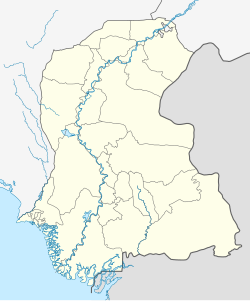Kotri
Appearance
(Redirected from Kotri Taluka)
Kotri
| |
|---|---|
| Coordinates: 25°22′26″N 68°18′05″E / 25.373964°N 68.301315°E | |
| Country | Pakistan |
| Province | Sindh |
| District | Jamshoro |
| Population | |
• City | 106,615 |
| • Rank | 118th, Pakistan |
| Time zone | UTC+5 (PST) |
Kotri (Sindhi: ڪوٽڙي, Urdu: کوٹری) is a city and the headquarters of the Kotri Taluka of Jamshoro District of Sindh province in Pakistan.[2] Located on the right bank of the Indus River, it is the 118th most populous city in Pakistan.[1]
Name
[edit]The name Koṭri is the diminutive form of the word koṭ, meaning "fort"; thus, the name means "little fort".[3]
Demographics
[edit]As per the 2023 Census of Pakistan, the population of Kotri city was recorded as 106,615. According to the 1998 Census, the population of the city was 62,085.[1]
Economy
[edit]Kotri is a hub for textile production and fishing.[4]
Education
[edit]Universities
[edit]- Mehran University of Engineering and Technology
- University of Sindh Jamshoro
- Liaquat University of Medical & Health Sciences
Notable people
[edit]- Ali Muhammad (1940 – 8 August 2016), known professionally as Ali Baba (Sindhi: علي بابا, Urdu: علی بابا), was a notable Sindhi-language drama writer and novelist. He was born in Kotri. He died on 8 August 2016 due to a heart attack in his home at Karachi.
References
[edit]Wikimedia Commons has media related to Kotri.
- ^ a b c "PAKISTAN: Provinces and Major Cities". Citypopulation.de website. Retrieved 9 April 2023.
- ^ "Historical Places of Dadu". Population Census Organisation, Government of Pakistan website. Archived from the original on 18 September 2008. Retrieved 9 April 2023.
- ^ Gidwani, Parso J. (1990). "Place-Names of Sindh". Bulletin of the Deccan College Post-Graduate and Research Institute. 49: 153–156. JSTOR 42930281.
- ^ Makhdoom, Tayyaba Rafique; Shah, Syed Abdul Sattar; Makhdoom, Faiza (2016). "Socio-economic well-being through fishing in Kotri downstream: should the river be kept on flowing?". The Government: Research Journal of Political Science. 5: 195–209.




